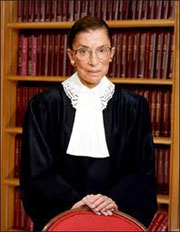Supremely Slanted
Table of Contents:
- Supremely Slanted
- Introduction
- Clarence Thomas
- Ruth Bader Ginsburg
- Stephen Breyer
- John Roberts
- Samuel Alito
- Sonia Sotomayor
- Elena Kagan
Ruth Bader Ginsburg
 After what the Times described as a “messy, semi-public search,” the Clinton White House was relieved to settle on a third choice, Judge Ruth Bader Ginsburg. The Times' initial main concern (the same it would later show with nominees Steven Breyer and Elena Kagan) was a political one.
After what the Times described as a “messy, semi-public search,” the Clinton White House was relieved to settle on a third choice, Judge Ruth Bader Ginsburg. The Times' initial main concern (the same it would later show with nominees Steven Breyer and Elena Kagan) was a political one.
But the Times wasn't concerned that Ginsburg, an ACLU lawyer and pioneering feminist litigator, was too liberal. Instead, reporters wondered if she was aggressively liberal enough to go toe to toe intellectually with conservative Justice Antonin Scalia. The Times' sparse coverage of Ginsburg featured a grand total of 4 liberal labels applied to the judge, and even those were tempered. In fact there were just as many centrist labels (4) for Ginsburg as well as many quoted statements suggesting she wasn't a liberal.
The Times made the most of occasional jabs from the pro-choice left about Ginsburg's criticism of Roe v. Wade on tactical grounds (Ginsburg thought equality would have been stronger ground for the decision than the right to privacy) to display her as some kind of judicial centrist, her past activism notwithstanding.
Neil Lewis penned a profile upon the announcement on June 15, 1993 suggesting Ginsburg was not vociferously liberal enough, while Richard Berke placed her at the “unpredictable center” on the U.S. Court of Appeals for the D.C. Circuit in another June 15 story. The same day, then-reporter Thomas Friedman set Ginsburg's thinking as “firmly in the centrist philosophical terrain chartered by Clinton in his campaign.” A June 25 story by David Margolick borrowed a golf metaphor from a Ginsburg friend, characterizing the judge as being a moderate through force of will, “aiming left, swinging right and hitting down the middle.”
This shifting of the ideological spectrum met its zenith in a June 27 headline by the reliable Neil Lewis under the headline: “Balanced Jurist at Home in the Middle,” in which Lewis praised Ginsburg's “resolutely centrist judicial style.” Lewis boasted that one of her decisions “provided a neat example of how elusive is her place on the philosophical spectrum of the Federal courts.” Lewis did call her a “Pioneering liberal litigator on women's rights” but immediately added that she had “practiced judicial restraint since President Jimmy Carter named her to the bench in 1980.”
On July 20, the day her Senate Judiciary Committee hearings began, Lewis emphasized: “Judge Ginsburg...was chosen by President Clinton for her resolutely centrist stands as much as anything else,” and of “inhabiting the ideological middle of an important court...” Lewis described Ginsburg's burden, “if it can be called that, is that she is a centrist,” unlike failed nominee Robert Bork, who “had the burden of an image that he was far to the right of the legal mainstream.” The headline promised: “High Court Nominee Faces Easy Road Through Senate.” The Times did its best to provide one.
Even when reporters admitted Ginsburg was a political liberal, the admissions were qualified with adjectives. Linda Greenhouse on July 22 called the judge “a judicial-restraint liberal” but implied she would not be a judicial activist but instead had, as the story headline stated, “A Sense of Judicial Limits.” Summing up the insipid hearings three days later, Greenhouse admitted the nominee “came across as a liberal,” but qualified that by asserting “Judge Ginsburg's liberalism is tempered by her belief in a restrained and cautious role for judges.” Thomas certainly wasn't bolstered by those kind of reassurances in the Times, though he made similar denials of judicial advocacy at his hearings (which the Times did not take at face value).
The hagiography increased upon Ginsburg's confirmation, as shown by the August 2 headline “Ginsburg's Spirit Is Echoed by Other Pioneers.”Greenhouse ended her August 4 story on Ginsburg's confirmation (by a healthy 96-3 margin) by quoting the question of another reporter at the ceremony, who asked Ginsburg:“You've been called a liberal, you've been called a conservative, you've been called a moderate. What are you?” The Times feigned confusion on the very same matter as Ginsburg coasted to easy confirmation.


